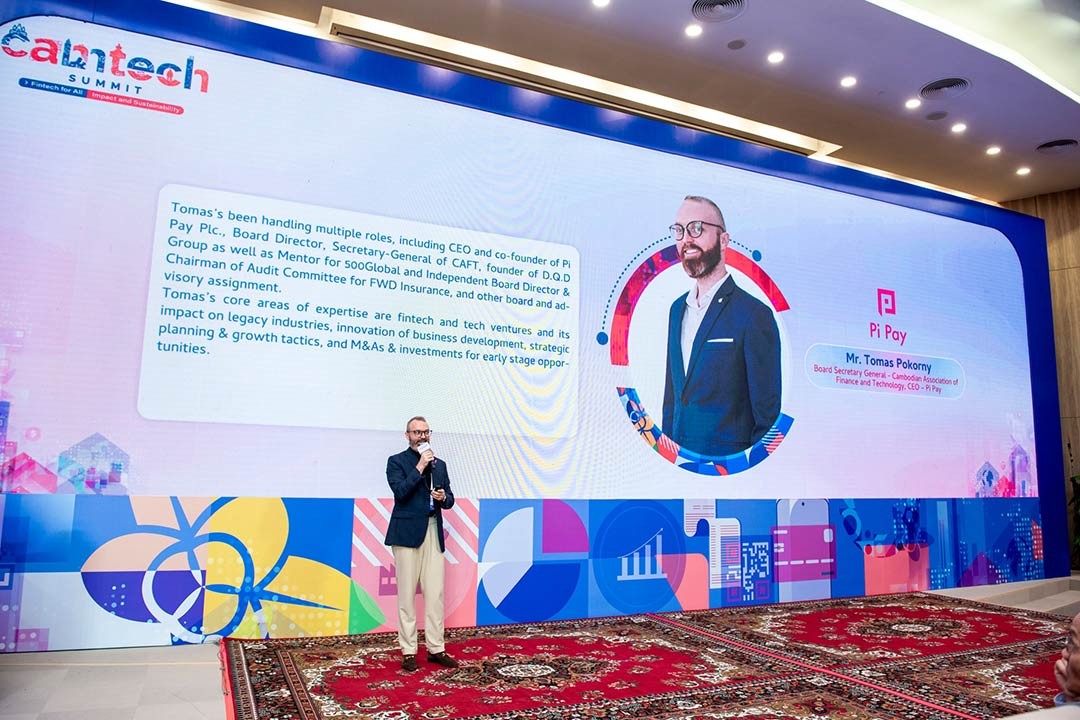Advancements In Cambodia’s Finance And Technology Sector – Tomas Pokorny, CAFT Secretary General

On the opening morning of CamTech Summit 2024, held at the Centre for Banking Studies (CBS) in Phnom Penh on September 18, Tomas Pokorny, Board Director & Secretary-General of the Cambodia Association of Finance & Technology (CAFT), delivered a presentation breaking down how Cambodia's digital financial landscape has evolved over the years and where it is expected to go from here. B2B Cambodia also spoke with Pokorny after his presentation to go more in depth on the subject. We break down the main highlights and explore the question of what's next.
Cambodia’s Digital Financial Transformation
Tomos Pokorny is a well-recognised figure in Cambodia’s digital financial scene, having been a founder, investor and board member across several businesses and associations.
During his presentation, the current CAFT Secretary-General emphasised that the digital landscape in Cambodia has changed drastically over the past 5-7 years.
“I have been across multiple countries and regions and based in Cambodia since 2011, and the digital economy then was practically non-existent and in its infancy,” said Pokorny.
There have been so many things that have happened in Cambodia over recent years that we can not recap them all.
Since digital banking was introduced in Cambodia in 2017, he noted that the country has really leapfrogged others, driven by regulatory support and technological innovations. Among these leading innovations were the introduction of the Bakong payment system by the NBC, subsequent cross-border payment partnerships, as well as digital assets and blockchain development, which have driven financial inclusivity.
“Bakong transactions… rose to USD 55 billion just in the first six months of 2024, which is almost double the size of Cambodia’s GDP… which is very unusual compared to many other countries in the region,” Pokorny told B2B Cambodia.
“And that’s driven also by digital commerce and e-commerce, both formal and informal,” he added.
This showcases the Cambodia is really one of the fastest evolving and strongest growing countries when it comes to digital payments, but also digital commerce, especially on the social commerce and informal commerce front.
Some of the most important milestones that have impacted the digital landscape in Cambodia and e-commerce he highlighted were:
- There are approximately 18 million people in Cambodia, including foreign residents, but there are currently more than 19.7 million digital wallets – the growth has been driven by Bakong and KHQR adoption.
- Cambodia recorded USD 75.8 billion in digital transactions in 2023.
- Bakong alone accounted for USD 55 billion in H1 2024 compared to USD 33.77 in 2023.
Watch a snippet of Tomas Pokorny's presentation from CamTech Summit 2024:
Pokorny also acknowledged that more recently there has been adoption from regulators and the private sector in deploying digital assets and sandbox initiatives, and stressed that it's only been in the years following the pandemic that people can now go nearly anywhere in Cambodia while cashless.
Unique Aspects Of Cambodia’s Digital Financial Landscape
What makes Cambodia somewhat unique in the region, explained Pokorny, is the existence of a uniform payment and QR infrastructure compared to more developed markets. He highlighted the major concerted push from the Cambodian government to implement this system as what contributed to the rapid speed of adoption and rate of development.
“What makes [Cambodia] different is that many countries took it kind of organically and slowly, developing [digital payments] step-by-step,” he said. “[Oftentimes] there were already card schemes present, there were big financial players, for example, in China, Alipay and WeChat Pay, which were present first before there was any introduction of government driven digital payments… so it came kind of in drip feed motion.”
On the other hand, he shared that Cambodia took on the route of solid government initiative with the implementation of Bakong, and offered India as another example in Asia of a similar public sector drive to make a common digital payment system.
[This initiative] made the common payment system unified, and everybody can suddenly participate… So what other countries would take 10-15 years to develop, it essentially happened across five years [in Cambodia].
Some of the recent conducive laws, regulations and developments Pokorny highlighted were:
- 2019 – Adoption of Law On Electronic Commerce
- 2020 – Bakong system launched in Cambodia
- 2023 – Cambodian Financial Technology Development Policy (2023-2028)
- 2023 – Digital Economy and Social Policy (2021-2035)
- 2024 – Expansion of Bakong Cross-Border Payments
While the government’s push has been crucial for the country’s digital financial landscape, he stressed that the private sector’s role was still key to ensuring these developments went smoothly.
“If [the government] went for it, and there wasn’t private sector buy-in, it could have just been one of the many frameworks deployed but not adopted, right? So public-private collaboration was still needed,” said Pokorny.
Challenges In Cambodia’s Digital Financial Landscape
These rapid developments have been greatly beneficial to the Cambodian economy, however, they also bring in new challenges along with the opportunities.
One of the major ‘prices to pay’ from rapid growth in the digital financial landscape is related to security and trust.
“Cambodia has been subject to many, many financial scams and fraud. I'm sure that many… have been receiving those SMS codes to participate in games which are probably pure scams or fraud,” shared Pokorny.
Not just between B2B (business-to-business), but also between B2C (business-to-consumer), [the question now is] how do we advocate and educate people about who to trust and how to properly verify?
“It's not just about cybersecurity and having antivirus [software], it's also about how educated people are about what to trust. So this security element, overall, is definitely a big challenge that needs to be addressed for sure,” he added.
Another long-standing challenge that has persisted in Cambodia is the issue of lacking connectivity, not just in the provinces, but even with urban spaces. Pokorny said that as the digital financial landscape seeks to further develop and become more sophisticated, major changes and upgrades will be necessary in Cambodia’s digital infrastructure.
“I don’t even mean in terms of business connections, but just from the user perspective, it’s not ideal. We don't have the bandwidth that is advertised, that's the unfortunate truth,” he said.
Something needs to happen with the rapid growth of digital transactions and digital commerce… If nothing happens, we cannot grow anymore. We will get stuck, and it's already happening, so people just need to talk about it more.
Watch B2B Cambodia's interview with Tomas Pokorny and highlights from CamTech Summit 2024:
What’s Next For FinTech In Cambodia?
Pokorny said that in expanding Cambodia’s financial reach, there are four key drivers: integration, connections to other countries such as Thailand, Vietnam and South Korea, development of partnerships, and Cambodia’s Pentagonal Strategy.
Enabling secure digital transactions for digital commerce and eKYC has also been vital for the growth (and trust in the payment systems)
- eCommerce in Cambodia is expected to be valued at US $1.1 billion in 2024 and $1.7 in 2028
- Facebook is still the leading social media platform in Cambodia with 10.45 million users and it is estimated that nearly one-third of all online users frequently engage in E-commerce transactions (buying online).
Interestingly, the informal economy is a key driver in the growth of eCommerce and digital payments in Cambodia. As many as 6.9 million in Cambodia are involved in informal employment, said Pokorny, and only 3.5 per cent of enterprises are registered, so in reality, the digital economy is probably much larger than currently measured.
Because of this, he said the main concepts CamTech 2024 wished to highlight and introduce to the Cambodian market were focused on open sharing infrastructures and data sharing, including open banking.
“These are not new concepts… but it's something that's missing... [because] Cambodia is driven by both formal and informal economies, especially on the digital commerce side,” said Pokorny “There's a lot of P2P transactions, a lot of customer-to-customer interactions, not just business to customer… and without open banking, an open data sharing infrastructure, it's still very clustered, so you need to have many, many solutions that are individualistically based in order to be part of a fully inclusive environment.”
Bakong was just one step that’s enabling joint payments, but now, an open data sharing infrastructure and open banking infrastructure can enable the technology to communicate with each other, and that's what's needed to fully close the circle.

Is Cambodia Embracing Digital Assets?
Cambodia is slowly adopting multiple digital assets and policies such as the Sandbox by the Ministry of Economy and Finance (MOEF) and NBC’s draft Prakas on digital assets and crypto, so Pokorny thinks Cambodia could become a developing markets financial hub for the Mekong Region.
The same morning that he spoke, H.E. Dr. Chea Serey, Governor of the National Bank of Cambodia (NBC) said “I hope you (the private sector) will take the opportunity to talk to us about your concerns, about your challenges, and how we can help you, but also I hope that you understand our position; that we are here to protect the system, we are here to protect the customers, and we're not here to stifle any innovation. If you are transparent with us, we will be transparent with you, and we will help you.”
Pokorny feels that Cambodia can be proof that even a small nation can have a global (regional) impact but also called for the following to see the growth continue:
From Regulators:
- Regulators to strengthen collaboration with fintech startups and financial institutions and have an agile regulatory environment and a framework which is comprehensive
- Promote open finance and an open digital economy
From Businesses:
- Tap into digital asset markets and finance and capitalise on unconquered digital frontiers
- Embrace e-commerce growth and adopt data sharing and open economy concepts.
Pokorny particularly pushed for a cross-governmental sandbox between different ministries and institutions as something that would be key for continued fintech innovation in Cambodia.
“Right now, the NBC has its own [system], the Ministry of Economy and Finance has its own, the Securities and Exchange Regulator has another, the Ministry of Post and Telecommunications… It's so many different sandboxes and environments. It doesn’t have to be a fully E-government solution, but a fully unified E-government sandbox, [on the other hand] is, I think, a good stepping stone when it comes to trial and error and testing in a safe environment to prepare for what will happen 5-10 years from now.
“Without that unified government [instructure], we will get stuck again, because for that data sharing and open infrastructure, we will need unified government regulatory frameworks done,” he concluded.